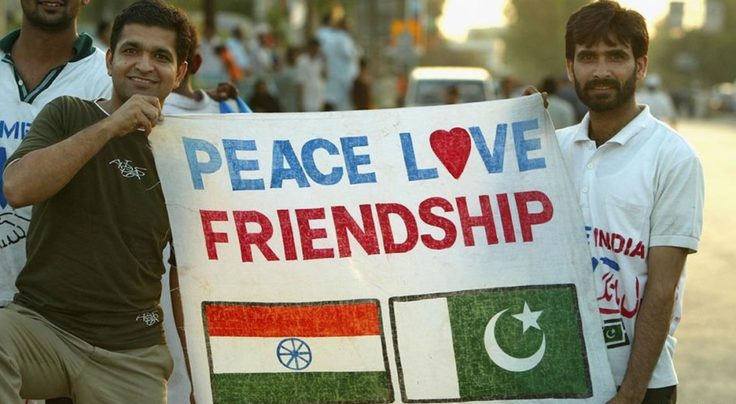
The out-pour on twitter about #IndiaPakistan last year is telling of a story. It is the story about the urge to communicate, to say things out, and out loud when you want to, when you need to, when you have to. Trending most recently on the social media has been the solidarity hashtags – #IndiaWithPakistan and #PakWithIndiaNoToLakhviBail – in response to the Tehrik-e-Taliban Pakistan’s cold-blooded murder school children in #Peshawar and the bail given to the 26/11 #MumbaiAttack mastermind Zaki-ur Rehman Lakhvi by Pakistan’s Anti Terrorism Court. On other occasions this year, the India-Pakistan war-of-the-hashtags was seen through #BorderBetrayal, #ModimeetsSharif and #RoIndiaRo. The hashtag is no longer just an attention-catching metadata symbol to trend topics; it is evolving into a system of communication. Thousands of social media users in India and in Pakistan, many of whom are unknown to each other, have been communicating with each other through the #tag. Ruhee and Tanvi exchange some thoughts on the trend.
Does symoblism matter?
In the aftermath of the Peshawar attack, Indians expressing one sentiment or another were predictably categorised into camps with relative ease. If you took to Twitter to condemn the tragedy of innocent deaths and made the mistake of hashtagging #IndiawithPakistan, you were a wishy-washy liberal – one of today’s most dangerous criminals – who had yet to confront the insidious reality of Pakistan and its death wish not just to willingly implode but to take India down with it. If you condemned the military for pushing Pakistan to the precipice and charged Pakistanis with displaying false outrage, you were a war-mongering rabble-rouser. Viewing people as one or the other – ‘with’ Pakistan and therefore somehow naïve about the centres of power within it and the threats it continues to pose to the Indian state, or, ‘against’ Pakistan and therefore capable of hard-hitting punditry that denounces any act of goodwill as ultimately foolish – is ultimately unhelpful.
When did observing a two-minute silence for the lives lost become political give and take? Does it matter whether the children were Indian or Pakistani? Does one’s genuine outrage immediately preclude the possibility of one also acknowledging that the tragedy of Peshawar seems to have facilitated the possibility of national consensus-building, in which contrary opinions that question violent action by the state are likely to be sidelined? Or to be capable of censuring the Pakistani establishment for releasing the purported mastermind of the Mumbai 26/11 attacks on bail, that too no less than days after being subjected to a horrendous act of terrorism within their own borders? Logic would answer these questions in the negative.
In a moment of crisis, grief can traverse boundaries. Solidarity in grief is seen as a weakness, a temporary blindness that does not allow you to confront the political realities of a rival state. One who is capable of empathy can also be equally capable of censure – not all situations are going to be judged alike. Condemnation of the Peshawar attack does not make one anti-India, just as criticism of a lack of compassion does not mean one wishes to bandwagon with Pakistani hyper nationalists who believe that India has a hand in every act of wrongdoing within Pakistan.
While we are not fans of the #IndiawithPakistan hashtag itself, we can appreciate what it represents. Without any channels of proper physical communication, symbolism becomes crucial as a (sometimes unsophisticated) means to demonstrate that it takes all sorts to make a country. You can have a Pakistan critic, you can have a Pakistan sympathiser, and you can have one who is both. The situation determines the response, and it would be better all around to avoid broad brushstrokes to classify people as either this or that. It does everyone – including the classifier who for all practical purposes is only identifying categories for his/her own ease of understanding – a huge disservice. One is capable of more subtlety than that.
Open windows and closed doors
The spur in across-the-border #interactions, facilitated by the social media revolution, is not necessarily depictive of the interactions between Indians and Pakistanis outside of the virtual world. How much do we really know each other, beyond what television and the Internet have to offer? Even with its ease, access, speed and sometimes anonymity, communication through a screen and cyberspace (which is closely-monitored by national agencies) gives a manifest sense of distance and doesn’t hold the same charm and spontaneity of face-to-face interactions.
There aren’t very many Indians and Pakistanis who are able to sit down together over a #cup of chai or a plate of #kababs. And if you have, you’ve probably felt the ease of interaction – it’s not just the language, Bollywood films and cricket, but topics like Kashmir and nuclear weapons also open a shared cultural space for interaction. Casual sit-downs and personal interactive experiences between Indians and Pakistanis are luxuries enjoyed among diaspora, in the diplomatic circles of the two countries or by those ‘ordinary’ Indians and Pakistanis who meet each other in ‘neutral’ countries. Tight visa restrictions by both India and Pakistan have for the longest time marred social and cultural interactions between people on the two sides. The fair bit of people-to-people contact that has been established – for instance, student exchange programmes –are sporadic and vulnerable to the fragile political state-of-affairs.
While #interactions are a great way to communicate beyond borders, they are typical of long-distance relationships – not that they don’t succeed, but that they come with the peculiar difficulties of judgement and maintenance of the relationship. We are capable of more than just hashtag conversations.
***